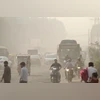A recent Greenpeace India report highlights alarming air quality issues in three major Karnataka cities: Bengaluru, Mangaluru, and Mysuru. The findings indicate that particulate matter (PM2.5 and PM10) levels in these cities are significantly higher than the World Health Organization’s guidelines. In areas like Hyderabad and Chennai, PM2.5 levels are six to seven times above safe limits. The report emphasizes the need for proactive air quality management and region-specific standards to combat rising pollution levels. Greenpeace advocates for improved air quality monitoring, investments in renewable energy, and public awareness campaigns to encourage sustainable practices. These insights serve as a crucial reminder for local governments to enact long-term strategies for cleaner air.
Title: Air Quality Crisis in Karnataka’s Major Cities: Greenpeace Report Highlights Alarming Pollution Levels
In a concerning new report by Greenpeace India, the air quality in three major cities of Karnataka—Bengaluru, Mangaluru, and Mysuru—has been found to be deteriorating. The report, titled ‘Spare the Air 2,’ reveals that levels of particulate matter (PM2.5 and PM10) in these cities are soaring, significantly exceeding the air quality standards set by the World Health Organization (WHO).
According to the report, PM2.5, which refers to fine particulate matter less than 2.5 micrometers in diameter, poses serious health risks. The analysis encompasses air quality data from ten southern cities, including Hyderabad, Chennai, and Visakhapatnam, indicating that the average PM2.5 levels in several of these areas are six to seven times higher than WHO guidelines.
Lead researcher Akanksha Singh emphasizes that clean air is essential for health. She points out that while efforts often focus on cities failing to meet national air quality standards, it is equally important to manage pollution in cities that currently comply. Proactive measures can prevent them from slipping into non-compliance.
Specifically, the report highlights that Bengaluru, Puducherry, and Mysuru exceed PM10 levels by four to five times compared to WHO guidelines. Greenpeace India’s campaigner, Selomi Garnaik, advocates for a health-based approach to revising the National Ambient Air Quality Standards (NAAQS), tailored to the unique pollution challenges of southern cities.
The report calls for increased investment in an ‘hybrid’ air quality monitoring system, which would provide real-time public access to crucial air quality information. It also encourages local governments to promote renewable energy solutions and develop targeted action plans to combat pollution effectively.
Avinash Chanchal, Greenpeace India’s campaign manager, warns against the misconception of cleaner air in southern states, urging governments to adopt comprehensive and long-term strategies to tackle persistent pollution sources. From vehicle emissions to industrial output, it is essential to address the major contributors to air quality deterioration.
As the air quality crisis in Karnataka unfolds, it serves as a crucial reminder for both citizens and policymakers to take immediate action for a healthier environment.
Tags: Air Quality, Greenpeace India, Karnataka, PM2.5, Pollution, Health Risks, WHO Guidelines, Environmental Awareness, Renewable Energy
-
What warning has Greenpeace India issued for Bengaluru and other cities?
Greenpeace India has warned that the air quality in Bengaluru, Mangaluru, and Mysuru is poor and could harm people’s health. -
Why is the air quality in these cities a concern?
The poor air quality can lead to health problems like respiratory issues, especially for children and the elderly. -
What causes the bad air quality in these places?
The bad air quality is often caused by vehicle emissions, industrial pollution, and construction dust. -
What can people do to protect themselves from poor air quality?
To stay safe, people can wear masks, avoid outdoor activities during high pollution days, and keep windows closed. - Is this issue affecting many people?
Yes, poor air quality affects a lot of people in these cities, making it important for everyone to be aware and take action.
)





